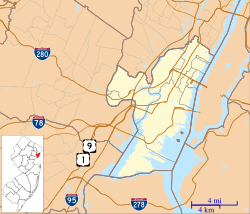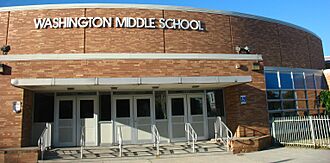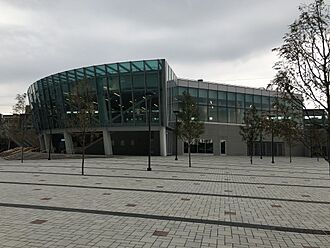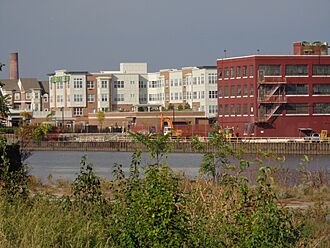Harrison, New Jersey facts for kids
Quick facts for kids
Harrison, New Jersey
|
||
|---|---|---|
|
Town
|
||
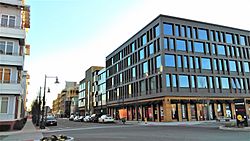
Urby Harrison, January 2018
|
||
|
||
| Motto(s):
"Beehive of Industry"
|
||
| Country | ||
| State | ||
| County | Hudson | |
| Incorporated | April 13, 1840 (as township) | |
| Reincorporated | March 25, 1869 (as town) | |
| Named for | William Henry Harrison | |
| Government | ||
| • Type | Town | |
| • Body | Town Council | |
| Area | ||
| • Total | 1.33 sq mi (3.44 km2) | |
| • Land | 1.21 sq mi (3.14 km2) | |
| • Water | 0.12 sq mi (0.30 km2) 8.72% | |
| Area rank | 466th of 565 in state 8th of 12 in county |
|
| Elevation | 20 ft (6 m) | |
| Population
(2020)
|
||
| • Total | 19,458 | |
| • Estimate
(2023)
|
20,520 | |
| • Rank | 142nd of 565 in state 9th of 12 in county |
|
| • Density | 16,061.1/sq mi (6,201.2/km2) | |
| • Density rank | 15th of 565 in state 8th of 12 in county |
|
| Time zone | UTC−05:00 (Eastern (EST)) | |
| • Summer (DST) | UTC−04:00 (Eastern (EDT)) | |
| ZIP Code |
07029
|
|
| Area code(s) | 973 | |
| FIPS code | 3401730210 | |
| GNIS feature ID | 0885245 | |
| Website | ||
Harrison is a small town in Hudson County, New Jersey. It's part of the busy New York metropolitan area. Harrison is like a suburb of Newark, New Jersey, and is only about 8 miles (13 km) from New York City.
Harrison used to be known as "the beehive of industry" because of all its factories. Now, it's changing into a place with more homes and businesses, especially along the Passaic River. In 2020, about 19,450 people lived in Harrison. This was a big jump from 2010!
Contents
History of Harrison, New Jersey
How Harrison Began
The land where Harrison is today was once part of a huge land grant given to William Sandford in 1668. Later, in 1671, this land was split between Sandford and his uncle. Sandford's share included the area that became Harrison.
In 1750, a road was built to the Hudson Waterfront. It was named after Douwe's Ferry, which helped people cross the Hackensack River. By 1795, two long bridges were built. One crossed the Hackensack River (950 feet or 290 meters), and the other crossed the Passaic River (492 feet or 150 meters). These bridges created a continuous toll road called the Newark Turnpike.
Becoming a Town
In 1826, a new area called Lodi Township was formed in Bergen County. But it was far from the county seat in Hackensack. So, in 1840, people from Lodi Township and other nearby areas asked for a new county. This led to the creation of Hudson County on April 13, 1840. This is when Harrison Township was first created.
The first meeting for Harrison Township was on April 16, 1840. Most people agree that Harrison was named after President William Henry Harrison, who was elected that same year.
Later, in 1867, Kearny became a separate township from Harrison. Then, on March 25, 1869, Harrison officially became a town.
The "Beehive of Industry"
In 1912, President William Howard Taft visited Harrison. He called it a "Hive of Industry." This led to the town's motto: "The Beehive of Industry," which is still used today.
Harrison was a great place for factories because it was close to train lines and the waterfront. Many important companies had factories here, like:
- Edison Lamp Works
- Worthington Pump and Machinery
- RCA Company
- Otis Elevator
- Hartz Mountain
These factories made many new products, especially during World War II. Even though Harrison was a small town with about 14,000 residents, over 90,000 workers came to work there every day! Today, Harrison is changing from a factory town to a town with more homes and service businesses.
Geography and Location
Harrison covers about 1.33 square miles (3.44 km2). Most of this is land, with a small part being water. A small area called Manhattan Transfer is also part of Harrison.
Harrison shares borders with:
- East Newark and Kearny in Hudson County.
- Newark across the Passaic River in Essex County.
Population and People
| Historical population | |||
|---|---|---|---|
| Census | Pop. | %± | |
| 1850 | 1,344 | — | |
| 1860 | 2,556 | 90.2% | |
| 1870 | 4,129 | 61.5% | |
| 1880 | 6,898 | 67.1% | |
| 1890 | 8,328 | 20.7% | |
| 1900 | 10,596 | 27.2% | |
| 1910 | 14,498 | 36.8% | |
| 1920 | 15,721 | 8.4% | |
| 1930 | 15,601 | −0.8% | |
| 1940 | 14,171 | −9.2% | |
| 1950 | 13,490 | −4.8% | |
| 1960 | 11,743 | −13.0% | |
| 1970 | 11,811 | 0.6% | |
| 1980 | 12,242 | 3.6% | |
| 1990 | 13,425 | 9.7% | |
| 2000 | 14,424 | 7.4% | |
| 2010 | 13,620 | −5.6% | |
| 2020 | 19,450 | 42.8% | |
| 2023 (est.) | 20,520 | 50.7% | |
| Population sources: 1850–1920 1850–1900 1850–1870 1850 1870 1880–1890 1890–1910 1870–1930 1940–2000> 2000 2010 2020 |
|||
Harrison's Population in 2020
In 2020, Harrison had 19,450 people living in 7,888 homes. The town was quite crowded, with about 16,061 people per square mile.
Here's a look at the different groups of people living in Harrison in 2020:
- 38.8% were White
- 5.9% were Black or African American
- 0.3% were Native American
- 19.8% were Asian
- 11.6% were from two or more races
- 51.4% of the population were Hispanic or Latino (of any race).
The average household income in Harrison was $68,494.
Harrison's Population in 2010
In 2010, Harrison had 13,620 people. About 31.8% of homes had children under 18. The average household had 2.80 people.
Here's a look at the different groups of people living in Harrison in 2010:
- 58.30% were White
- 2.18% were Black or African American
- 0.56% were Native American
- 16.28% were Asian
- 18.48% were from other races
- 4.19% were from two or more races
- 44.18% of the population were Hispanic or Latino (of any race).
Education in Harrison
The Harrison Public Schools teach students from kindergarten all the way through twelfth grade. The school district has four schools:
- Harrison Early Childhood Program (for Pre-K3 and Pre-K4)
- Lincoln Elementary School (Pre-K to 3rd grade)
- Hamilton Intermediate School (4th–5th grade)
- Washington Middle School (6th–8th grade)
- Harrison High School (9th–12th grade)
In the 2018–19 school year, there were 2,409 students and about 166 teachers. This means there were about 14 or 15 students for every teacher.
Community Groups
The Harrison Lions Club started on July 25, 1951. It's part of a big international group called Lions Clubs International. This club helps with projects related to sight and also supports other community programs in Harrison.
Getting Around Harrison
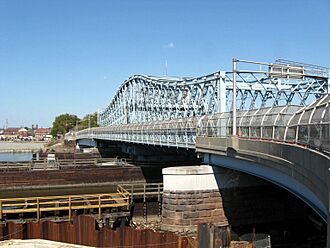
Roads and Highways
Harrison has about 18 miles (29 km) of roads. Most of these are kept up by the town itself. Interstate 280 runs right through the middle of Harrison. This highway connects to other major roads like the Garden State Parkway and the New Jersey Turnpike.
There are plans to improve I-280 in Harrison. This will make it easier to get to Harrison Avenue, the PATH station, and Sports Illustrated Stadium.
Public Transportation
The Harrison station is part of the PATH train system. You can take the PATH train from Harrison to:
The Harrison PATH station was first built in 1913. It was moved in 1936. A big renovation of the station was finished on June 15, 2019, making it much more modern.
NJ Transit buses also serve Harrison. You can catch buses on routes 30 and 40.
The closest airport with passenger flights is Newark Liberty International Airport. It's about 4.8 miles (7.7 km) away in Newark and Elizabeth.
Harrison Waterfront Development
Harrison has a plan to redevelop its waterfront area. This plan covers about 275 acres (1.1 km2) of the town. The goal is to build new homes, shops, and businesses that are easy to reach by walking or public transport. The plan also wants to connect new buildings with Harrison's history and its location by the Passaic River. This will help create a new identity for Harrison and make it a popular place to visit.
Sports Illustrated Stadium
Harrison is home to Sports Illustrated Stadium. This is where the New York Red Bulls soccer team plays in Major League Soccer. It's also the home of NJ/NY Gotham FC from the National Women's Soccer League.
The stadium opened on March 20, 2010. It cost $200 million to build. It can hold about 25,000 fans. The stadium has a natural grass field and a wavy roof that covers all the seats. It sits right by the Passaic River, offering views of the New York and Newark skylines. You can easily get to the stadium using the PATH train.
Famous People from Harrison
- Angelo M. "Chubby" Cifelli (born 1939), a singer, songwriter, and musician.
- Dave D'Errico (born 1952), a former professional soccer player.
- Samuel Taylor Darling (1872–1925), a scientist who studied diseases.
- Sam Dente (1922–2002), a baseball player who played from 1947 to 1955.
- Bhairavi Desai, a founder of the Taxi Workers Alliance in New York.
- Jack Dunleavy (1879–1944), a baseball player in the early 1900s.
- Bernard Epstein (1920–2005), a mathematician and physicist.
- Robert Firth (1918–1984), a United States federal judge.
- Tom Florie (1897–1966), a soccer player who played in the American Soccer Leagues. He is in the U.S. National Soccer Hall of Fame.
- Daisy Fuentes (born 1966), a model, actress, and former MTV VJ.
- Joe Gardi (1939–2010), a college football coach at Hofstra University.
- Kevin Gilmore (1949–1970), a college football player who died in a plane crash.
- Fred A. Hartley Jr. (1902–1969), who served ten terms in the U.S. House of Representatives.
- Marty Kavanagh (1891–1960), a Major League Baseball player.
- Ray Lucas (born 1972), a former NFL quarterback for the New York Jets.
- Edward F. McDonald (1844–1926), who represented New Jersey in Congress.
- Patrick "Paddy" McGuigan (1860–1938), a bare-knuckle boxer.
- Matt Pinfield (born 1961), a music personality and TV host for MTV and VH1.
- Henry Pogorzelski (1922–2015), a mathematician.
- Tab Ramos (born 1966), a retired soccer midfielder.
- Frank E. Rodgers (1909–2000), a politician who was Mayor of Harrison for 48 years.
- Fred Shields (1912–1985), a soccer player who played in the 1936 Summer Olympics. He is in the National Soccer Hall of Fame.
- Omar Sowe (born 2000), a soccer player for New York Red Bulls II.
- Joe Stripp (1903–1989), a Major League Baseball player.
- Aloysius Michael Sullivan (1896-1980), a poet, editor, and author.
- Bill Summers (1895–1966), a baseball umpire in Major League Baseball.
- George Tintle (1892–1975), a soccer goalie. He is in the National Soccer Hall of Fame.
See also
 In Spanish: Harrison (Nueva Jersey) para niños
In Spanish: Harrison (Nueva Jersey) para niños



